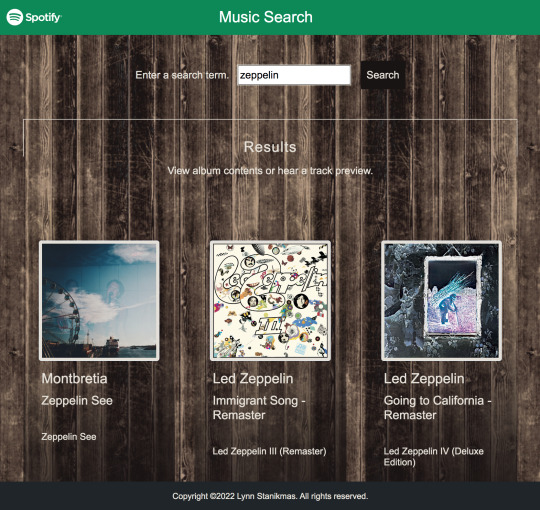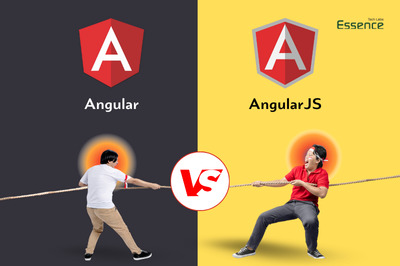#angular development companies
Explore tagged Tumblr posts
Text
Set off on an adventure to learn about India's top Angular development firms, renowned for being the first to use the Angular framework. These elite companies are the ideal partners for companies looking to improve their online visibility since they provide creative, scalable, and reliable Angular solutions. Top Angular development firms include eSparkBiz, Sagacity, Aayan India, and Phontinent Technologies. At the vanguard of this innovation are the leading Angular development firms mentioned above, providing knowledge and services to a clientele that spans the globe. Your web applications will advance to the forefront of the digital era if you partner with one of these companies, which guarantees access to complete Angular development services.
0 notes
Text







Angular SPA integrated with the Spotify Web API returns JSON metadata about music artists, albums, and tracks, directly from the Spotify Data Catalogue.
#angular#spotify#my music#firebase#firestore#data#database#backend#html5#frontend#coding#responsive web design company#responsivewebsite#responsivedesign#responsive web development#web development#web developers#software development#software#development#information technology#developer#technology#engineering#ui ux development services#ui#ui ux design#uidesign#ux#user interface
2 notes
·
View notes
Text
Hire Full Stack Developers for Seamless Solutions | Sensation Solutions
Looking to hire full stack developers for your business? Sensation Solutions offers top-notch full stack developers with expertise in front-end and back-end technologies. Our skilled developers deliver seamless solutions tailored to your specific needs, ensuring optimal functionality, performance, and user experience. With Sensation Solutions, you can build robust web applications, scalable mobile apps, and innovative software solutions. Get in touch today and hire our dedicated full stack developers to enhance your development projects and drive your business forward.
#Hire Full Stack Developers#Full Stack Development Company#Hire Mean Stack Developers#Mean Stack Development Company#Hire MERN Stack Developers#MERN Stack Development Company#Hire Dot net Developers#Dot net Development Company#Hire PHP Developers#PHP Development Company#Hire Front-end Developer#Hire Angular Front End Developer#Hire Social Media Expert
1 note
·
View note
Link
Looking for Angular JS Development Services? Try out the leading Angular JS Development Company for instant assistance. Hire us now!" />
2 notes
·
View notes
Text
0 notes
Text

Leading Angular Development Company in USA | Cogtix Solutions
Experience cutting-edge Angular development with Cogtix Solutions – the leading Angular development company in USA. Elevate your web presence today!
0 notes
Text

Top Angular Development Company - Build Robust Web Applications
QServices is a leading angular development company that specializes in building dynamic and scalable web applications using the powerful framework. Trust our experts to deliver cutting-edge solutions tailored to your business needs. Explore our services today!
#angular development services#angular development company#hire angular developer#hire angular js developer#angular js development
0 notes
Text
Top Angular Web Development Company in India for Scalable Solutions
At WebWorx, an expert Angular web development company in India, we create dynamic, feature-rich web applications tailored for businesses of all sizes. Our services cover UI/UX design, single-page applications, and seamless third-party integrations. Our strategic approach ensures high performance and adaptability. Let’s build your next-gen web solution today!
0 notes
Text
Build Future-Ready Web Solutions with an Angular Development Company USA

Future-proof your digital presence with Angular. As an experienced Angular development company USA, we develop robust, secure, and high-speed applications that enhance business efficiency and improve search engine rankings.
#business website#web design#web development services#website design agency#top angular development agency#angular js development agency#angular development company USA
0 notes
Text
Find the top Angular development firms that specialize in producing dynamic, scalable, and inventive online apps. These companies stand out in the tech industry thanks to their technical expertise, strategic strategy, and dedication to providing outstanding digital experiences. Companies like eSparkBiz, Fluvius Software, Nextware Technologies, Viagio Technologies provide the best services of Angular development. eSparkBiz is well-known for its creative Angular development methods and creates custom solutions that propel company expansion. If you want to know more about the Angular Development Companies, read this blog
0 notes
Text
Best Practices For Securing SaaS Applications With Workflow Apps.
Read Full Blog Hear,
Visit Website, Glasier Inc.
Our Blogs
Other Services,
hospital management system
erp software development company
Hire Angular Developers
Hire SaaS developer
Hire Flutter Developers
Hire ReactJs Developers
#hire SaaS developers#Hire SaaS developer#hire dedicated developers#custom software develpment#hire angular developers#best seo agency in india#app development#app development cost#advertising#website#offshore developers#web development#ios application development services#laravel development services#app developing company
2 notes
·
View notes
Text
Why You Should Stop Using AngularJS in 2025 & Upgrade to Angular
📌 Google officially ended support for AngularJS – but why are companies still using it? 🤔
🚀 Here’s why you should migrate NOW:
Performance Boost: Angular 18+ is faster and more efficient than AngularJS.
Security Risks: AngularJS apps are vulnerable due to a lack of updates.
Future-Proofing: Angular is actively developed and supported.
💡 Want to know the full comparison? Read it here:👇
Angular vs AngularJS in 2025: Critical Differences Every Developer Must Know
🔗 #Angular #AngularJS #WebDevelopment #JavaScript #SoftwareEngineering #TechTrends

#web development services#angular#website design company#angularjs#frontenddevelopment#mobile app development
0 notes
Text
0 notes
Text

Learn how Angular can enhance your mobile app development, offering powerful features for seamless cross-platform applications. Explore the benefits of using angular for mobile app development, from scalability to easy integration with other tools, and why it’s a top choice for developers.
0 notes
Text
Isn't the front end of apps like Netflix and PayPal user-friendly? Well, yes, they are! Have you ever been curious about the secret behind it? Everything boils down to the fact that these applications were created with Angular. You would be amazed to know that over 300,000 websites are using Angular. That is true! Presently, Angular development is growing to be more popular. Though initially designed for single-page applications, the technology is increasingly used for mobile, business, and progressive web apps. Read more.
0 notes
Text

As a trusted Angular development company, we provide innovative web applications tailored to your needs. Recognized as a leading Angular development company India, our expertise ensures exceptional results. Choose us as your Angular web development company for robust and dynamic solutions.
#angular development company#angular development company india#angular development company in india#angular web development company
0 notes